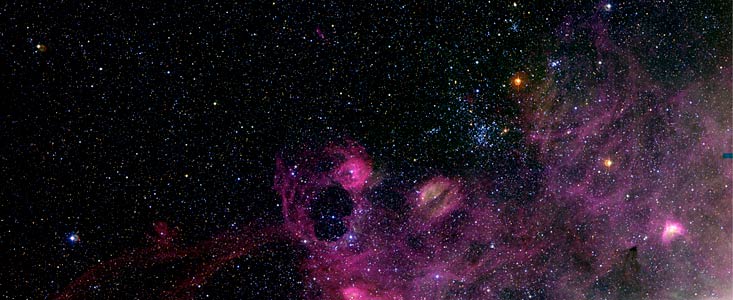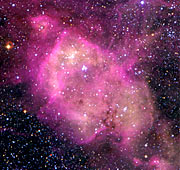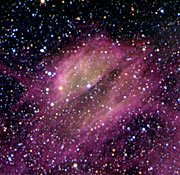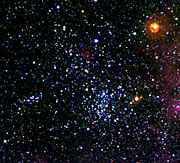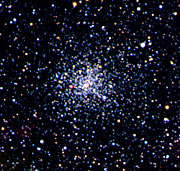Press Release
Caught in the Cobweb
Turbulent and Colourful LMC Region Imaged from La Silla.
10 December 2004
The Tarantula Nebula is one of the most impressive views in the Southern sky. Visible to the unaided eye in the Large Magellanic Cloud (LMC), a satellite galaxy of the Milky Way that is located in the direction of the southern constellation Doradus at a distance of about 170,000 light-years, this huge nebula is the prototype of what astronomers refer to as a "Giant HII region". In this complex of glowing gas and very hot and luminous stars, the gas is mainly composed of protons and electrons, which are kept apart by energetic photons emitted by the stars in this area.
The Tarantula Nebula (also designated 30 Doradus) owes its name to the arrangement of its brightest patches of nebulosity that somewhat resemble the legs of a spider. They extend from a central "body" where a cluster of hot stars (designated "R136") resides that illuminate the nebula. This name, of the biggest spiders on the Earth, is also very fitting in view of the gigantic proportions of the celestial nebula - it measures nearly 1,000 light years across!
While the central regions of 30 Doradus may be compared to a tarantula, the entangled filaments in the outskirts of this nebula could well be likened with its cobweb. They testify to an ongoing history of very vigorous activity and make this spectacular sky region a showcase of dramatic effects caused by the tremendous output of energy from the most massive stars known.
Intricate colours
The marvellous richness of the filament colours is due to the varying conditions in the interstellar gas in this region. The red in these images is caused by emission of excited hydrogen atoms, the green shades correspond to emission from oxygen atoms from which two electrons ("doubly-ionized oxygen") have been "knocked off" by the energetic radiation of hot stars in the R136 cluster, that is located beyond the lower right corner of this photo. The intensity of this emission increases towards R136, explaining the yellowish colour near the edge of the photo.
A blue colour is contributed by singly-ionized atoms of oxygen. Other atoms like nitrogen and sulfur at different levels of ionization also add to the emission of the nebula at specific wavelengths. The observed colours thus probe the physical condition of the emitting gas and the temperature of the star(s) that excite(s) it. The intricate appearance of the filaments is mostly a consequence of turbulence in the interstellar gas, of the magnetic fields, and of the energy input by the massive stars in the neighbourhood.
Supernovae blow interstellar "bubbles"
The large ring-shaped nebula slightly to the lower-left (South-East) of the centre of the first image is known as DEM L 299 [1] Detailed investigations show that it represents an "interstellar bubble" which was "blown" by supernovae explosions, most probably happening millions of years ago, as massive stars near the centre of this structure ended their comparatively short lives in glorious flashes.
A closer inspection shows that another supernova exploded somewhat later near the rim, forming a bright and more compact nebula known as SNR 0543-689 (ESO Press Release eso0437). Other supernovae in this general field exploded even more recently, such as the one that created the remnant B0544-6910 (ESO Press Release eso0437) only a few tens of thousands of years ago, a blink of an eye by all astronomical standards.
Nebulae with built-in powerhouses
Not all the nebulae seen in this region are caused by supernovae, however. The glow of N 164 [1], a bright, extended red-yellow nebula just below DEM L 299, is mostly due to its own "private" powerhouse, that consists of several massive stars deeply embedded in its interior.
The same holds for DEM L 297, the somewhat smaller and fainter nebula to the right of DEM L 299. It is divided into two half-circle formed segments by a dark lane of interstellar dust in front of it. Indeed, within the Tarantula complex many such dark and dusty clouds are seen in silhouette as they obscure bright nebulosity behind them.
Many stellar clusters
The outskirts of the Tarantula Nebula are also rich in stellar clusters. One of them, NGC 2093 [1], has relatively few stars and is relatively young, just a few tens of millions of years. It appears that its stars have already excavated a sizeable cavity around them that is now relatively void of gas.
An older and much more compact cluster, NGC 2108, is seen near the bottom of the first image. It resembles the globular clusters in our own Galaxy, but it formed much more recently, about 600 million years ago. Still, NGC 2108 is much older than the Tarantula complex and it is quite possible that in its "youth" it was the core of another giant HII region that has since dissolved into interstellar space.
The images for this release were produced by two ESO astronomers who are impressed by this sky region. Nausicaa Delmotte did the observations for her thesis and notes that: "many of the nebulae and clusters seen in these photos would stand out prominently if they were located elsewhere in the sky and not this close to the core of the spectacular Tarantula complex.". She is echoed by her colleague, Fernando Comeron: "This amazing concentration of clusters, HII regions, supernova remnants, and extremely hot and luminous stars in a single region makes the Tarantula in the LMC a unique celestial object, unrivalled in our own Galaxy and other nearby galaxies!".
Notes
[1] The designation "DEM L 299" indicates that this object is no. 299 in the list of nebulae in the Large and Small Magellanic Clouds published in 1976 by astronomers R.D.Davies, K.H.Elliott and J.Meaburn. "N" refers to a list of bright nebulae in these galaxies that was compiled in 1956 by K.G.Henize. "NGC" stands for the "New General Catalogue" published in 1888 by J.L.E. Dreyer.
More information
The present colour photo of the Northeastern outskirts of the Tarantula nebula in the Large Magellanic Cloud is based on three monochromatic images taken on 6 and 7 December 2001 with the Wide-Field-Imager (WFI) at the ESO/MPG 2.2-m telescope, through an U-band filter (with the forbidden emission line of singly-ionised oxygen, [OII], at wavelength 372.7 nm) and two narrow-band filters centred on the wavelengths of the forbidden line of doubly-ionised oxygen ([OIII], at 500.7 nm) and hydrogen (H-alpha line, at 656.2 nm), respectively. Each single-colour image is in turn composed of four individual frames of 20 minutes of exposure time each.
The WFI detector system is composed of eight individual 2k x 4k CCDs with small gaps between them; for this reason, the individual frames in each filter were obtained with the telescope pointing at slightly different positions in the sky, so that the parts of the sky falling in the detector gaps in any given frame are recorded on the others. A problem with one of the detector chips causes double stellar images to appear over a small, narrow strip near the upper left edge of the full field image. The monochromatic images were produced by superimposing the individual frames, correcting for the telescope offsets. Finally, the combined images in each filter were aligned and colour-coded to produce the resulting colour picture. North is up and East is left. The extensive image processing was performed by ESO-astronomers Fernando Comeron and Nausicaa Delmotte.
About the Release
| Release No.: | eso0437 |
| Legacy ID: | Photo 34a-h/04 |
| Name: | DEM L 297, DEM L 299, Large Magellanic Cloud, LMC, N 164, NGC 2093, NGC 2108, SNR 0543-689, SNR B0544-6910, Tarantula Nebula |
| Type: | Local Universe : Nebula : Type : Supernova Remnant |
| Facility: | MPG/ESO 2.2-metre telescope |
| Instruments: | WFI |
Our use of Cookies
We use cookies that are essential for accessing our websites and using our services. We also use cookies to analyse, measure and improve our websites’ performance, to enable content sharing via social media and to display media content hosted on third-party platforms.
ESO Cookies Policy
The European Organisation for Astronomical Research in the Southern Hemisphere (ESO) is the pre-eminent intergovernmental science and technology organisation in astronomy. It carries out an ambitious programme focused on the design, construction and operation of powerful ground-based observing facilities for astronomy.
This Cookies Policy is intended to provide clarity by outlining the cookies used on the ESO public websites, their functions, the options you have for controlling them, and the ways you can contact us for additional details.
What are cookies?
Cookies are small pieces of data stored on your device by websites you visit. They serve various purposes, such as remembering login credentials and preferences and enhance your browsing experience.
Categories of cookies we use
Essential cookies (always active): These cookies are strictly necessary for the proper functioning of our website. Without these cookies, the website cannot operate correctly, and certain services, such as logging in or accessing secure areas, may not be available; because they are essential for the website’s operation, they cannot be disabled.
Functional Cookies: These cookies enhance your browsing experience by enabling additional features and personalization, such as remembering your preferences and settings. While not strictly necessary for the website to function, they improve usability and convenience; these cookies are only placed if you provide your consent.
Analytics cookies: These cookies collect information about how visitors interact with our website, such as which pages are visited most often and how users navigate the site. This data helps us improve website performance, optimize content, and enhance the user experience; these cookies are only placed if you provide your consent. We use the following analytics cookies.
Matomo Cookies:
This website uses Matomo (formerly Piwik), an open source software which enables the statistical analysis of website visits. Matomo uses cookies (text files) which are saved on your computer and which allow us to analyze how you use our website. The website user information generated by the cookies will only be saved on the servers of our IT Department. We use this information to analyze www.eso.org visits and to prepare reports on website activities. These data will not be disclosed to third parties.
On behalf of ESO, Matomo will use this information for the purpose of evaluating your use of the website, compiling reports on website activity and providing other services relating to website activity and internet usage.
Matomo cookies settings:
Additional Third-party cookies on ESO websites: some of our pages display content from external providers, e.g. YouTube.
Such third-party services are outside of ESO control and may, at any time, change their terms of service, use of cookies, etc.
YouTube: Some videos on the ESO website are embedded from ESO’s official YouTube channel. We have enabled YouTube’s privacy-enhanced mode, meaning that no cookies are set unless the user actively clicks on the video to play it. Additionally, in this mode, YouTube does not store any personally identifiable cookie data for embedded video playbacks. For more details, please refer to YouTube’s embedding videos information page.
Cookies can also be classified based on the following elements.
Regarding the domain, there are:
- First-party cookies, set by the website you are currently visiting. They are stored by the same domain that you are browsing and are used to enhance your experience on that site;
- Third-party cookies, set by a domain other than the one you are currently visiting.
As for their duration, cookies can be:
- Browser-session cookies, which are deleted when the user closes the browser;
- Stored cookies, which stay on the user's device for a predetermined period of time.
How to manage cookies
Cookie settings: You can modify your cookie choices for the ESO webpages at any time by clicking on the link Cookie settings at the bottom of any page.
In your browser: If you wish to delete cookies or instruct your browser to delete or block cookies by default, please visit the help pages of your browser:
Please be aware that if you delete or decline cookies, certain functionalities of our website may be not be available and your browsing experience may be affected.
You can set most browsers to prevent any cookies being placed on your device, but you may then have to manually adjust some preferences every time you visit a site/page. And some services and functionalities may not work properly at all (e.g. profile logging-in, shop check out).
Updates to the ESO Cookies Policy
The ESO Cookies Policy may be subject to future updates, which will be made available on this page.
Additional information
For any queries related to cookies, please contact: pdprATesoDOTorg.
As ESO public webpages are managed by our Department of Communication, your questions will be dealt with the support of the said Department.
